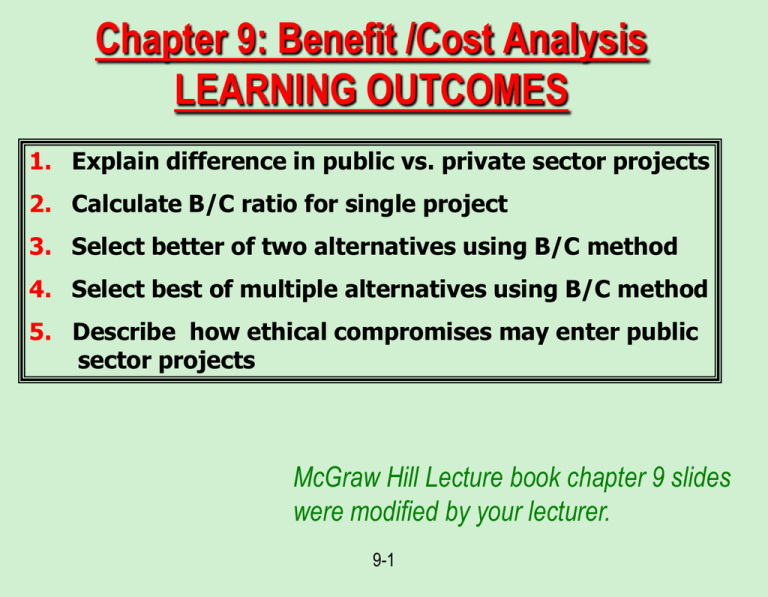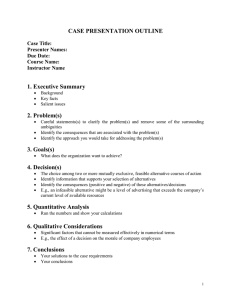
Chapter 9: Benefit /Cost Analysis
LEARNING OUTCOMES
1. Explain difference in public vs. private sector projects
2. Calculate B/C ratio for single project
3. Select better of two alternatives using B/C method
4. Select best of multiple alternatives using B/C method
5. Describe how ethical compromises may enter public
sector projects
McGraw Hill Lecture book chapter 9 slides
were modified by your lecturer.
9-1
Differences: Public vs. Private Projects
Characteristic
Public
Size of Investment
Large
Life
Annual CF
Funding
Interest rate
Selection criteria
Private
Small, medium, large
Longer (30 – 50+ years)
No profit
Shorter (2 – 25 years)
Profit-driven
Taxes, fees, bonds, etc. Stocks, bonds, loans, etc.
Lower
Multiple criteria
Environment of evaluation Politically inclined
9-2
Higher
Primarily ROR
Economic
© 2012 by McGraw-Hill All Rights Reserved
Cash Flow Classifications and B/C Relations
Must identify each cash flow as either benefit, disbenefit, or cost
Benefit (B) -- Advantages to the public
Disbenefit (D) -- Disadvantages to the public
Cost (C) -- Expenditures by the government
Note: Savings to government are subtracted from costs
Conventional B/C ratio = (B–D) / C
Modified B/C ratio = [(B–D) – C] / Initial Investment
Profitability Index = NCF / Initial Investment
Note 1: All terms must be expressed in same units, i.e., PW, AW, or FW
Note 2: Do not use minus sign ahead of costs
9-3
© 2012 by McGraw-Hill
All Rights Reserved
Decision Guidelines for B/C
Benefit/cost analysis
If B/C ≥ 1.0, project is economically justified at
discount rate applied
If B/C < 1.0, project is not economically acceptable
B-C ≥ 0 Project is economically acceptable
B-C < 0 Project is not economically acceptable
9-4
© 2012 by McGraw-Hill
All Rights Reserved
B/C Analysis – Single Project
Conventional B/C ratio =
B-D
C
Modified B/C ratio = B – D – M&O
C
If B/C ≥ 1.0,
accept project;
otherwise, reject
Denominator is
initial investment
Benefit cost difference=(Benefits-Disbenefits)-Costs
9-5
© 2012 by McGraw-Hill
All Rights Reserved
Example: B/C Analysis – Single Project
A flood control project will have a first cost of $1.4 million with an annual
maintenance cost of $40,000 and a 10 year life. Reduced flood damage is
expected to amount to $175,000 per year. Lost income to farmers is estimated
to be $25,000 per year. At an interest rate of 6% per year, should the
project be undertaken?
Solution: Express all values in AW terms and find B/C ratio
B = $175,000
D = $25,000
C = 1,400,000(A/P,6%,10) + $40,000 = $230,218
B/C = (175,000 – 25,000)/230,218
= 0.65 < 1.0
Do not build project
9-6
© 2012 by McGraw-Hill
All Rights Reserved
Defender, Challenger and Do Nothing Alternatives
When selecting from two or more ME alternatives, there is a:
Defender – in-place system or currently selected alternative
Challenger – Alternative challenging the defender
Do-nothing option – Status quo system
General approach for incremental B/C analysis of two ME alternatives:
Lower total cost alternative is first compared to Do-nothing (DN)
If B/C for the lower cost alternative is < 1.0, the DN option is compared to
∆B/C of the higher-cost alternative
If both alternatives lose out to DN option, DN prevails, unless overriding
needs requires selection of one of the alternatives
9-7
© 2012 by McGraw-Hill
All Rights Reserved
Alternative Selection Using Incremental B/C
Analysis – Two or More ME Alternatives
Procedure similar to ROR analysis for multiple alternatives
(1)
(2)
(3)
(4)
(5)
(6)
(7)
Determine equivalent total cost for each alternative
Order alternatives by increasing total cost
Identify B and D for each alternative, if given, or go to step 5
Calculate B/C for each alternative and eliminate all with B/C < 1.0
Determine incremental costs and benefits for first two alternatives
Calculate ∆B/C; if >1.0, higher cost alternative becomes defender
Repeat steps 5 and 6 until only one alternative remains
9-8
© 2012 by McGraw-Hill
All Rights Reserved
Example: Incremental B/C Analysis
Compare two alternatives using i = 10% and B/C ratio
Alternative
X
Y
First cost, $
M&O costs, $/year
Benefits, $/year
Disbenefits, $/year
Life, years
320,000
45,000
110,000
20,000
10
540,000
35,000
150,000
45,000
20
Solution: First, calculate equivalent total cost
AW of costsX = 320,000(A/P,10%,10) + 45,000 = $97,080
AW of costsY = 540,000(A/P,10%,20) + 35,000 = $98,428
Order of analysis is X, then Y
X vs. DN: (B-D)/C = (110,000 – 20,000) / 97,080 = 0.93 Eliminate X
Y vs. DN:
(150,000 – 45,000) / 98,428 = 1.07 Eliminate DN
9-9
© 2012 by McGraw-Hill
All Rights Reserved
Example: ∆B/C Analysis; Selection Required
Must select one of two alternatives using i = 10% and ∆B/C ratio
Alternative
X
Y
First cost, $
M&O costs, $/year
Benefits, $/year
Disbenefits, $/year
Life, years
320,000
45,000
110,000
20,000
10
540,000
35,000
150,000
45,000
20
Solution: Must select X or Y; DN not an option, compare Y to X
AW of costsX = $97,080
AW of costsY = $98,428
Incremental values: ∆B = 150,000 – 110,000 = $40,000
∆D = 45,000 – 20,000 = $25,000
∆C = 98,428 – 97,080 = $1,348
Y vs. X: (∆B - ∆D) / ∆C = (40,000 – 25,000) / 1,348 = 11.1 Eliminate X
9-10
© 2012 by McGraw-Hill
All Rights Reserved
B/C Analysis of Independent Projects
Independent projects comparison does not require
incremental analysis
Compare each alternative’s overall B/C with DN option
+ No budget limit: Accept all alternatives with B/C ≥ 1.0
+ Budget limit specified: capital budgeting problem; selection
follows different procedure (discussed in chapter 12)
9-11
© 2012 by McGraw-Hill
All Rights Reserved
Ethical Considerations
Engineers are routinely involved in two areas
where ethics may be compromised:
Public policy making – Development of strategy, e.g.,
water system management (supply/demand strategy;
ground vs. surface sources)
Public planning - Development of projects, e.g., water
operations (distribution, rates, sales to outlying areas)
Engineers must maintain integrity and impartiality and
always adhere to Code of Ethics
9-12
© 2012 by McGraw-Hill
All Rights Reserved
Summary of Important Points
B/C method used in public sector project evaluation
Can use PW, AW, or FW for incremental B/C analysis, but must
be consistent with units for B,C, and D estimates
For multiple mutually exclusive alternatives, compare two at a time
and eliminate alternatives until only one remains
For independent alternatives with no budget limit, compare each against
DN and select all alternatives that have B/C ≥ 1.0
Ethical dilemmas are especially prevalent in public sector projects
Note: Remember that this is not the only material covered in
class, make sure you have the rest as lecture notes. EA
9-13
© 2012 by McGraw-Hill
All Rights Reserved




